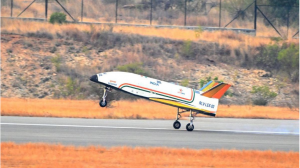ForumIAS announcing GS Foundation Program for UPSC CSE 2025-26 from 19 April. Click Here for more information.
ForumIAS Answer Writing Focus Group (AWFG) for Mains 2024 commencing from 24th June 2024. The Entrance Test for the program will be held on 28th April 2024 at 9 AM. To know more about the program visit: https://forumias.com/blog/awfg2024
Source-This post on Pushpak Reusable Landing Vehicle (RLV) LEX 02 landing experiment is based on the article “ISRO successfully conducts ‘Pushpak’ Reusable Landing Vehicle landing experiment“ published in “The Hindu” on 22nd March 2024.
Why in the News?

ISRO has successfully tested the Pushpak Reusable Landing Vehicle (RLV) LEX 02 in Chitradurga, Karnataka.
About Reusable Landing Vehicle (RLV) LEX 02
This test, the second one in the sequence after RLV-LEX-01, showcased the autonomous landing capability of the RLV, known as Pushpak.
| Reusable Landing Vehicle (RLV) 1. The RLV is conceptualized as a space plane with a low lift-to-drag ratio, requiring an approach at high glide angles that necessitates landing at high velocities of 350 km/h. 2. This design allows it to transport payloads to low Earth orbits and return to Earth for future use. 3. It uses various indigenous systems, including localized navigation based on pseudolite technology, along with instrumentation and sensor systems developed by ISRO. Note- The Reusable Launch Vehicle-Technology Demonstrator (RLV-TD) Programme is designed as a sequence of technology demonstration missions aimed at achieving a fully reusable Two Stage To Orbit (TSTO) vehicle. Read more– Reusable Launch Vehicle (RLV) |
What was the method used for the experiment?
1. Challenging autonomous landing– The RLV LEX-02 mission showcased the autonomous landing ability of the reusable launch vehicle, named Pushpak, under challenging conditions after being released from a Chinook helicopter at 4.5 km altitude.
2. Automatic control adjustments– It approached the runway autonomously, making adjustments as needed, and landed precisely using its brake parachute, landing gear brakes, and nose wheel steering system.
3. RLV-LEX-01 System reuse– All flight systems from RLV-LEX-01 were reused in this mission after receiving necessary certifications.
4. Agencies involved– The mission was carried out by Vikram Sarabhai Space Centre (VSSC), Liquid Propulsion System Centre (LPSC), and ISRO Inertial Systems Unit (IISU).
UPSC Syllabus- Science & Technology




